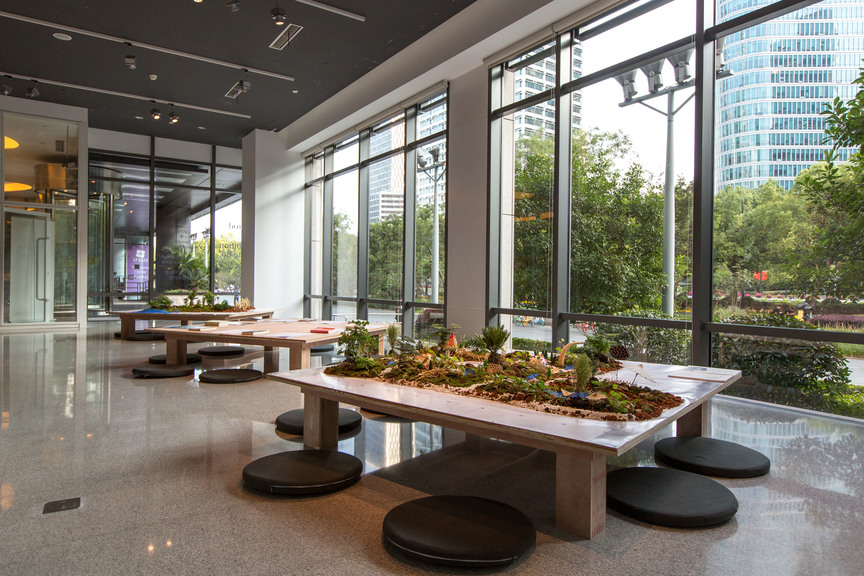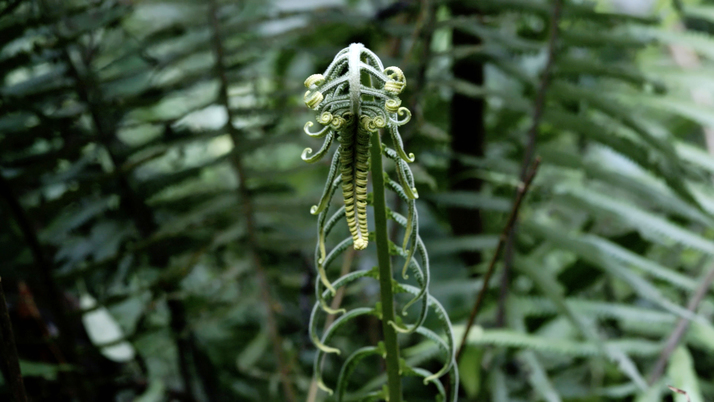-
From Current Issue
-
- Editor’s Letter Fire in the Heart
- Reviews I Gusti Ayu Kadek Murniasih
- Reviews 11th Seoul Mediacity Biennale: “One Escape at a Time”
- Dispatch Networked China
- One on One Monira Al Qadiri on Yukio Mishima
- Essays The rise of independent art spaces in pandemic-era Shanghai
- Features Tuan Andrew Nguyen
- Table of Contents
- Web Exclusives
- Archive
- Subscribe

R
E
V N
E
X
T
Installation view of ZHENG BO’s (foreground, left) Eco-Socialist Garden, NYU Shanghai, 2019, workshop, maquettes, and ephemera; and (background, right) 72 Relations with Canadian Goldenrod, 2019, site-specific installation, charcoal on wood panel, 124 × 32 cm, at “Goldenrod,” Institute of Contemporary Arts (ICA) at New York University (NYU) Shanghai, 2019. Photo by Hong Xiaole. Courtesy of ICA at NYU Shanghai.
After a two-year hiatus, the Institute of Contemporary Arts at the New York University (NYU) in Shanghai reopened with the research project “The (Invisible) Garden,” of which Zheng Bo’s “Goldenrod” was the inaugural presentation. The ongoing project, slated to run through the first quarter of 2021, aims to “consider the garden and ask how might we denature Nature?,” which in turn raises the question: why?
The genesis for the project, as Zheng recounted in his opening address, was learning of NYU’s plan to build a new Shanghai campus with a garden at the center. Zheng took this opportunity to assemble a team, largely composed of NYU students and academics, to collectively imagine a garden of “more-than-human sociality and eco-quality,” a concept that imagines humans as equal stewards of nature with all its living inhabitants. Their workshops laid the groundwork for the exhibition, which featured a short corporate-sounding manifesto (“Our garden must nourish. Our garden must connect. Our garden is non-toxic.”), two architectural models of the proposed garden, and a reading station with a selection of texts on climate change, ecology, and environmental politics.
The model gardens comprise a mixture of plastic plants and real seedlings displayed without any means of feeding or watering them, arranged atop specially commissioned furniture. This temporary furniture, made from laminated and processed timber through a wasteful and toxic procedure, is far from what one would imagine within a utopian eco-quality garden. Furthermore, the gardens themselves, broken into zones including “Happy Farm,” “Lovers Beach,” and “Parliament of Ten Thousand Things” (a place where the power of managing the garden is shared “among all creatures living here,” as represented by plastic toy animals) were overwhelmingly anthropocentric—11 of the 16 zones are dedicated centers for human activity. Is this what is meant by “denaturing Nature?”
Notably, among the 16 workshop participants invited by Zheng, only two were practicing landscape architects, and one an ecologist; none were gardeners or members of the general public. Although the end users of this garden would most likely be students and faculty members, the future campus is situated in an area of Shanghai which, prior to urban redevelopment in the early 2000s, was predominantly farmland, with the farmers still residents of the area. It seemed myopic that such a project would not include at least one representative of this community, whose rich knowledge of the local ecology represented a missed opportunity for the program.
The second part of the exhibition consisted of a large purpose-built room for displaying four video works: Pteridophilia 1–4 (2016–19).The titular term, coined by Zheng, means a fetish for pteridophyta, or flowerless green plants. Each of the four videos feature young, queer men engaged in various sexually charged encounters in the lush, tropical environs of Taiwan. Fronds are licked, sucked, and caressed, sometimes to the point of irreparable harm, while the men sprawl naked across boughs and mounds of earth. Long, almost pornographic scenes unfold with a frustrating slowness, leaving one in want of documentary information. But therein lay a problem: the young men are not pteridophiliacs, but rather actors who are cyphers for the artist’s own desires. Zheng has said of the project, “The older I am, the stronger love I have for plants.” Yet, just how the video works connect to the academic garden exercise is unclear.
As for the goldenrod of the show’s title, 72 Relations with Canadian Goldenrod (2019) is a charcoal drawing on a wooden panel of an invasive plant that was introduced to Shanghai during the early 20th century. The curatorial text explained that Zheng was drawn to the weed due to the sexual innuendo surrounding its name, as well as its symbolism as a product of the colonizing of modern China.
Installation view of ZHENG BO’s 72 Relations with Canadian Goldenrod, 2019, site-specific installation, charcoal on wood panel, 124 × 32 cm, at “Goldenrod,” ICA at NYU Shanghai, 2019. Photo by Hong Xiaole. Courtesy ICA at NYU Shanghai.
The sum of these parts unfortunately did not add up to a cohesive whole; instead, they float like a series of unfinished thoughts. Additionally, the displays highlighted an apparently irreconcilable aspect of contemporary art that seeks to address pressing ecological issues: that it in fact perpetuates the very problems that it hopes to ameliorate, due to the profligate usage of non-recyclable materials, and the inability to escape anthropocentric approaches.
Zheng Bo’s “Goldenrod” is on view at the Institute of Contemporary Arts at NYU Shanghai, until December 21, 2019.
To read more of ArtAsiaPacific’s articles, visit our Digital Library.


















